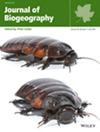How Geomorphology Maps the Dispersal Barriers of Large Herbivorous Mammals in China
Abstract
Aim
Literature and fossil records document the long-term occurrence sites of large herbivorous mammals in China. These sites exhibit spatially uneven distribution, potentially reflecting constraints on the dispersal of large herbivorous mammals imposed by stable geomorphic factors. In this study, we examine the impact of landforms on the dispersal of four taxa of large herbivorous mammals across China.
Location
China.
Taxon
Rhinocerotidae, Elephantidae, Equus, Camelus.
Methods
We employed the Omniscape algorithm to create a connectivity model from geomorphic data (slope, elevation and ground cover), assessing the extent to which Chinese landforms obstruct large herbivore dispersal. This model utilised historical distribution sites to delineate barrier strips.
Results
Dispersal barriers show regional variation, segmenting China into four distinct regions. The Tibetan Plateau, Taklamakan Desert and Qinling Mountains constitute Region A, presenting the most significant barrier. Region B, characterised by dense, continuous mountain ranges and arid landforms in Northwest China, poses a secondary barrier. Region C, with fragmented mountain ranges in Southwest China, exhibits a diminished barrier effect. Region D features the eastern coastal plains with minimal geomorphic constraints.
Conclusions
The edge mountains of the Tibetan Plateau form a continuous barrier strip. The Qinling–Taihang–Yanshan mountain chain constitutes a discontinuous barrier strip. This is because the mountain chain belongs to two geological structural units and is eroded by rivers, creating many corridors.

 求助内容:
求助内容: 应助结果提醒方式:
应助结果提醒方式:


